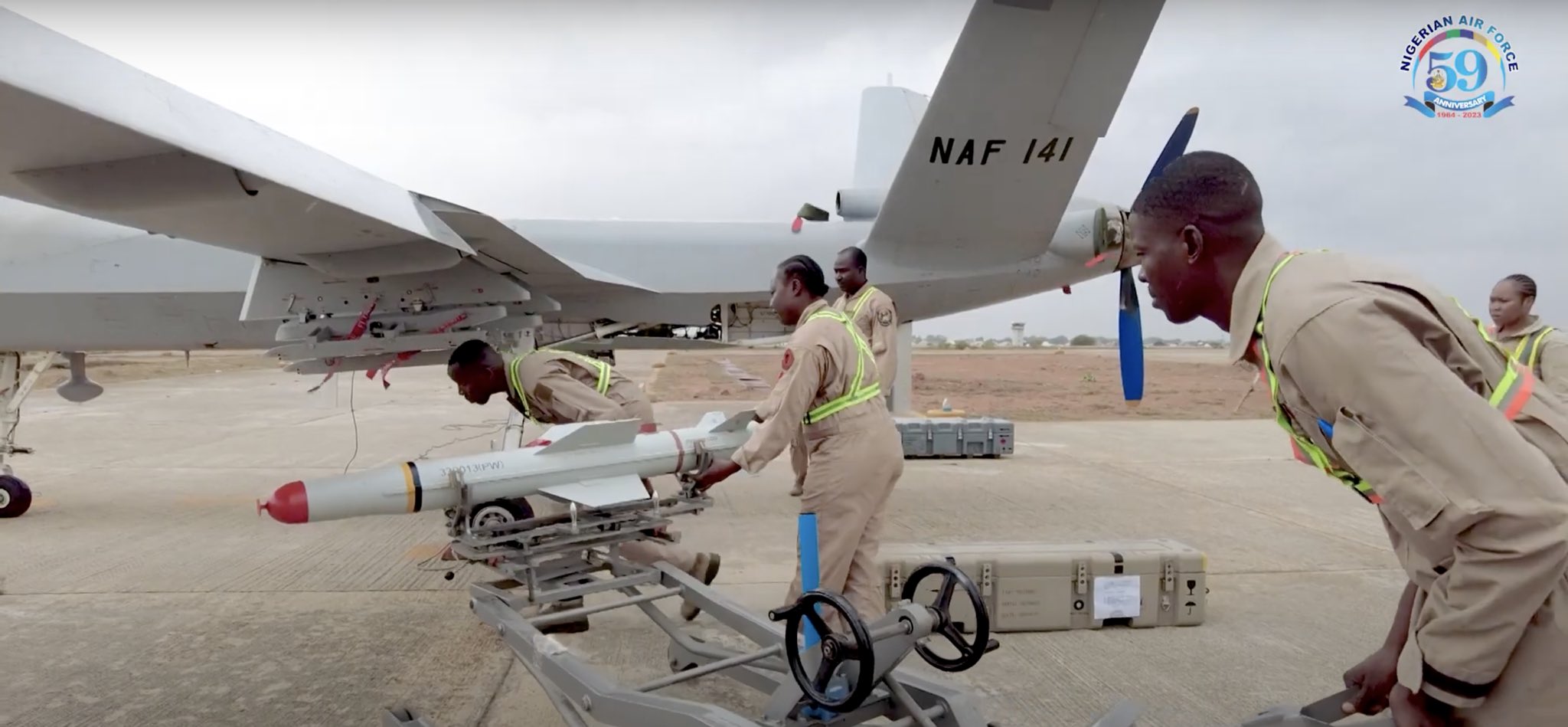Nigerian air force (NAF) recently carried out airstrikes at the hideout of the terrorist organization Boko Haram in a three-day operation from June 9 to 11, eliminating more than 100 terrorists, as per reports.
‘Groundbreaking Response’ To Hypersonic Threats, Israel Announces Anti-Hypersonic ‘Sky Sonic’ Interceptor Missile
The notorious terror outfit has been involved in dozens of blasts, kidnappings, and assassination cases in Nigeria. The NAF targeted the Jamā’at Ahl as-Sunnah lid-Da’wah wa’l-Jihād (JAS) faction of Boko Haram.
The NAF also released footage from airborne electro-optical systems, possibly from a Chinese-made Wing Loong 2 (WL-2) drone used to carry out one of the hits following its absorption only a month ago. Other reports said that the US-Brazilian Embraer Super Tucano aircraft also conducted some of the attacks in the three-day operation.
However, there was no official statement from the Nigerian Air Force (NAF) on the operation. Based on social media posts on recent anti-terror aerial strikes, recent weapons inductions, and the technical configuration of both aircraft, the Chinese UAV could have been used in the operation’s concluding days.
Three-Day Operation To Break Boko Haram’s Back
According to reports, these strikes were conducted between June 9 and 11 in the fringes of Gwoza Local Government Area of Borno State in northeast Nigeria. Specifically, the attacks were in the Grazah and Wa-Jahode areas around the Mandara mountains, which the militants have converted into their fortified stronghold, exploiting the hilly terrain and making ground operations extremely difficult.
The Daily Post said that the strikes were intelligence-led and were called Operation Warun 3, with the “first airstrikes carried out in Grazah in a location administered by the Boko Haram terrorists, which also serves as their meeting point.” These strikes were carried out by the A-29 Super Tucano single-propeller ground attack, according to the report.

“Ground assessment by sources revealed that the Super Tucano Aircraft scored accurate hits which resulted in the elimination of a number of the Boko Haram unit commanders and high-value fighters while many more who escaped were seriously injured,” it added.
The story then claimed the latter half of the operation was also a success but did not specify the aerial platforms employed.
“Consequently, on June 11, the Air Component carried out follow-up strikes in Wa-Jahode, which has been confirmed very successful, as many terrorists were neutralized and others said to be in critical condition. The Air Component also destroyed many structures,” The Daily Post report added.
China’s Wing Loong 2 UAV Used In Current & May Strikes?
Other strikes are likely to have been carried out by the WL-2, going by Tweets showing their formal induction and involvement in previous operations. Five WL-2 drones were commissioned into the NAF, with serial numbers from NAF 141 to 145. In pictures of the induction ceremony on May 8, only the 141, 144, and 142 could be seen.
Subsequently, on May 20 and 21, Tweets carrying pictures and videos of the NAF ground crew strapping weapons on one of the WL-2 (NAF 141) emerged. The payload was AG-300M and TL-2 air-to-surface missiles, as per the tweets.
❗️🇨🇳🤝 🇳🇬
A video of the Nigerian Air Force's 'Wing Loong 2' reconnaissance and strike drone imported from China conducting airstrikes on Bokoharam terrorists Hideout, drone is fitted with Tianlei-2 air-to-ground missiles and AG300M medium-range air-to-ground missiles#Nigeria pic.twitter.com/EFC6eUFZ48
— OsintTV 📺 (@OsintTV) May 21, 2023
Nigerian drone pilots then enter their ground control station, and the thermal view feed from the electro-optical system shows vehicles and ground targets struck by the munitions. One of the hits is from a laser-guided missile, with the laser being seen ‘blinking’ on the ground target before the munition strikes it.
On June 12, a day after the operation was said to have ended, a video circulated on the Chinese social media platform Weibo. It showed a large congregation of several dozen persons outside a large house.
The targeting feed in thermal view showed a munition hitting the corner of the roof, with debris flying around. This strike could be the follow-on strike on June 11, with the platform used in the attack being the WL 2.
HORRIBLE !!
Insane footage of Nigerian Air Force’s aerial strike on Boko Haram militants reportedly in Mandara Mountains.
It is claimed by Nigerian media that the strike eliminated around 100 militants.#Nigeria #BokoHaram #NAF @NigAirForce #UAV #strike #Borno #OperationWarun pic.twitter.com/QwGm2ALZ3q— EurAsian Times (@THEEURASIATIMES) June 14, 2023
Another reason this second strike could not be a Super Tucano work is that not all the NAF planes seem to have belly-mounted EO pods. Only six of the aircraft carry the cameras.
Thus, with reports not mentioning the make of the aerial platform used for the second strike in the June 9 and June 11 operation, the emergence of the EO feed the next day on June 12, and the participation of WL 2s in the last attack in late-May, indicates that the Chinese aircraft must have been employed against Boko Haram.
- The author can be reached at satamp@gmail.com
- VIEWS PERSONAL OF THE AUTHOR
- Follow EurAsian Times on Google News